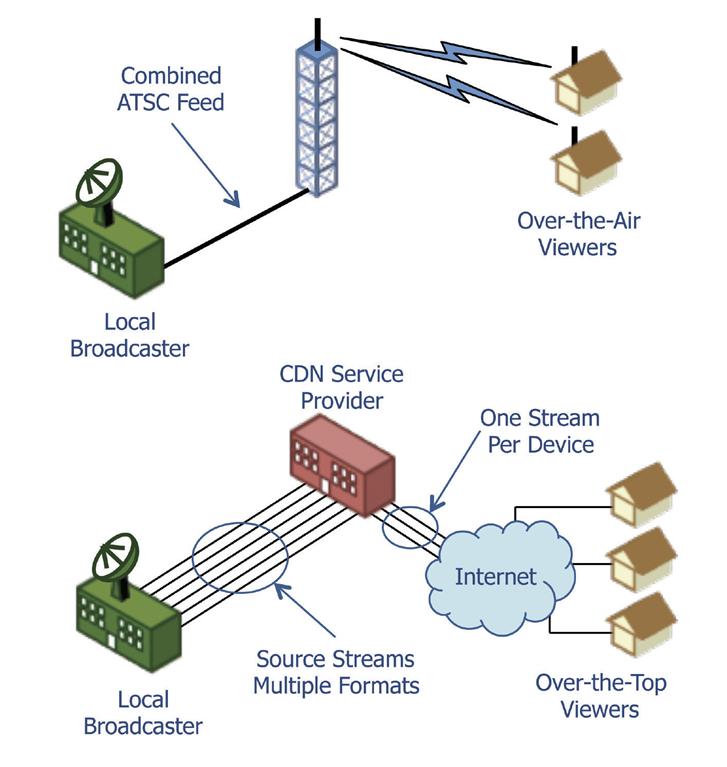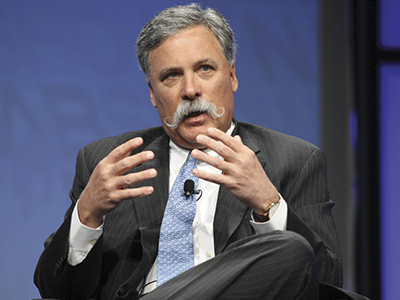Can TV Broadcasters Really Go OTT?

Fig. 1: The architecture of a traditional broadcast signal flow vs. one using OTT delivery.
ORANGE, CONN.—The ongoing legal drama between Aereo and over-the-air broadcasting operations has been well documented in the press. However, the technical impact of a broadcast television station going completely off-air could also be significant. Becoming an Internet-only broadcaster (also known as “over the top” or OTT), will require a different operational workflow, and creation of a new relationship with station viewers. While there are proven solutions that exist today to handle all of these technical challenges, implementing them to work on a 24/7 basis for a large viewing audience may stretch the technical and financial capabilities of many broadcasters.
WORKFLOW CHANGES
If a television station was to go off-the-air completely, workflow changes would be required. Along with the transmitter being turned off, the need for MPEG-2 encoding would go away (unless that format was still necessary for delivery to CATV and DTH satellite providers). Instead of a single ATSC feed (often with multiple subchannels), the broadcaster would have to produce feeds at multiple bit-rates in two or more streaming formats (at least to handle both Apple and non-Apple devices). Streams would also have to be created for each subchannel. These signals would then need to be fed into a Content Distribution Network that would create a copy of a stream to feed to each viewing device (Internet-connected TV, PC, tablet, etc.). Fig. 1 compares the architecture of a traditional broadcast to one using OTT delivery.
Any new OTT broadcast workflow would most likely be based on H.264/AVC using streaming formats such as Apple’s HTTP Live Streaming (HLS) and Adobe’s HTTP Dynamic Streaming (HDS), with a possible migration to Dynamic Adaptive Streaming over HTTP (DASH) if that standard gains traction in the marketplace.
But this is all a fait accompli for broadcasters, according to Jen Baisch, senior director of product marketing for iStreamPlanet, a Las Vegas-based provider of streaming technology. “Broadcasters are already migrating much of their programming to OTT, so these technologies are a move they have to make regardless.”
CONSUMER DEVICES
For the viewer, switching from over-the-air to OTT can be a significant effort. Any recent-vintage television set has a built-in digital tuner that works only with OTA signals. To receive OTT content, two things need to be provided: an Internet connection, and a method to receive a stream and decode it. Some recent televisions have built-in Internet TV receivers, but many others will need some kind of external device such as a Roku, Xbox, Web-enabled Blu-ray player or some other device that can receive and decode the OTT signals.
Some consumers might need to upgrade their Internet connections, particularly if multiple televisions are going to be watched at the same time. With an inexpensive 3 Mbps Internet connection, watching two 1 Mbps streams simultaneously could be difficult for consumers, especially if other devices were also accessing the Internet.
The professional video industry's #1 source for news, trends and product and tech information. Sign up below.

Chase Carey, president and COO of News Corp., shook up the NAB Show’s opening session with talk of Fox breaking from the free broadcast model and switching to a subscription-only service.
DATA USAGE
Consumer data caps could interfere with a viewer’s desire to watch lots of live programming from an Internet-only broadcaster. These caps are everywhere for mobile devices connected through 3G/4G LTE mobile networks, and may be present on some wired Internet services. Data usage caps are typically expressed in terms of gigabytes per month, with mobile contracts in the 2-10 gigabyte range, and some wired services have caps in the 200-300 gigabyte range.
If a live HD stream runs at 2 Mbps, one hour of viewing time on one device amounts to 0.84 gigabytes of data consumption. If the viewer watched this stream two hours a day for a month, 50 gigabytes of data would be consumed. For most consumers at home using wired Internet, data usage most likely wouldn’t be a major problem. For mobile device users, even those with relatively generous data plans, watching any significant amount of programming will be difficult at high bit-rates.
From a provider standpoint, live streaming to millions of viewers could get expensive. According to David Tice, senior vice president of GfK Media & Entertainment, a Singapore-based media research firm, “based on the results from our 2012 survey, just over 20 million households in the U.S. currently receive television exclusively over the air, with an average of 2.7 television sets per household. Another 17 percent of pay TV households have at least one television that relies on broadcast.” With a total of 96 million households who pay for television service, that figure represents at least another 16 million televisions that currently receive their signals entirely from broadcast, bringing the total OTA-dependent television population up to 70 million units.
If OTA-only televisions are distributed evenly across the United States, a metropolitan area such as New York (which contains 7.3 percent of the total U.S. population) could be expected to have a similar fraction of the OTA-only devices, or 5.1 million sets. If five percent of these sets were tuned to a broadcaster’s signal (as could be achieved for a popular sports or entertainment event) 255,000 OTT video streams would need to be created.
To generate this quantity of data, a number of servers and network interfaces would be required. At 1.5 Mbps per stream, total traffic volume of 383 Gbps would be required. There would also be a cost to deliver these streams, since CDN services charge for each gigabyte of data delivered. Although these costs are low for high volumes of data, they do mount up. Delivering one hour of programming to this many viewers at a rate of, say, $.03 per gigabyte would cost $4,815.00. Another way to look at CDN costs is to consider that a viewer who consumed 50 gigabytes of programming per month would cost a broadcaster $1.50.
GEO-BLOCKING
Much of a typical broadcast day is made up of programming that a local broadcaster doesn’t own, including syndicated game shows, talk shows, and other programming. Content rights agreements may limit a broadcaster to transmitting these signals only to viewers within a local broadcast area. Live sporting events pose a similar challenge, where local households may need to be prevented from seeing a sporting event that is subject to blackout rules. A technology called “geoblocking” is widely used by CDN providers to control the geographic locations where live streams are delivered, although implementing it securely for millions of viewers could be challenging.
“Broadcasters will likely need some sort of player application that can be authenticated for local viewers in order to implement geoblocking in a comprehensive manner,” said Alex Borbely, senior director of live linear operations for iStreamPlanet.
Overall, the technologies required for going completely OTT are well established and available from multiple sources. The real challenges for broadcasters to go completely OTT are related to the scale and cost of the traffic required, and managing the rights for each viewer; not to mention the potential loss of viewers who are unable or unwilling to connect their televisions to the Internet.
Wes Simpson is President of Telecom Product Consulting, an independent consulting firm that focuses on video and telecommunications products. He has 30 years experience in the design, development and marketing of products for telecommunication applications. He is a frequent speaker at industry events such as IBC, NAB and VidTrans and is author of the book Video Over IP and a frequent contributor to TV Tech. Wes is a founding member of the Video Services Forum.

